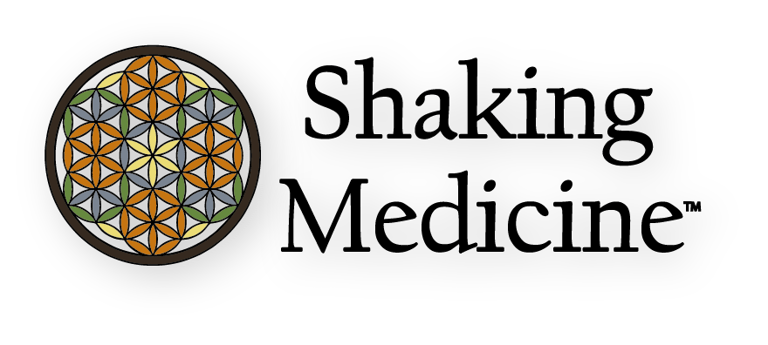Add your promotional text...
Precautions for a Safe Therapeutic Tremoring Practice
Learn about the safety precautions for practicing therapeutic tremoring effectively. Discover Shaking Medicine’s safety tips for approaching this somatic healing modality with care and caution. Find out if this is for you and how to get extra support if you need it.
FOUNDATIONS
Dr Keith R. Motes
9/11/202513 min read


Practicing Shaking Medicine Safely
Safety Precautions are a vital and evolving topic within our Shaking Medicine ecosystem. I’m sharing our guidelines here to increase awareness and ensure everyone can practice therapeutic tremoring safely and effectively. Therapeutic tremoring, the focal point of Shaking Medicine founded by Dr. Keith R. Motes, is a somatic healing practice that releases stress, anxiety, and trauma while promoting nervous system regulation. This practice is generally very safe, and most people can handle standard intro level Shaking Medicine classes. We recommend a “less is more” approach where your connection to your innate tremor mechanism is sustainably grown. For those with extreme or severe conditions, getting professional medical advice, starting with guidance from a certified Shaking Medicine Teacher and/or booking a personalized coaching session is highly recommended. This ensures your therapeutic tremoring practice is safe, empowering, and effective for lifelong benefits. Always keep in mind that Shaking Medicine is not designed to diagnose anything and we aren't offering medical advice.
Why Safety Matters in Therapeutic Tremoring
Therapeutic tremoring, as practiced in Shaking Medicine, engages the autonomic nervous system to release tension and emotions. While safe for most, proper precautionary measures prevent overwhelm, ensuring a therapeutic tremoring practice that fosters resilience, sustainability, and greater well-being. Our guidelines, inspired by Science, Yoga, Qi Gong, Somatics and pioneers like Dr. Peter Levine, Dr. Bradford Keeney, and many more (see our roots blog post), emphasize gradual progression and lots of self-regulation to suit your unique needs.
Key Safety Goals:
Support sustainable somatic healing without overwhelm.
Empower intuitive, personalized tremoring.
Ensure safety for all, especially those with severe conditions.


Sustainable Practice: Build Gradually for Lasting Benefits
There’s no need to rush the release of tension, stress, anxiety, trauma, or suppressed emotions through Shaking Medicine. It will happen organically as you embody this, so no need to force or overdo. A sustainable and consistent practice with adequate integration time between is more effective and beneficial than attempting to address everything in a single session or a short period of time. In SM, you are encouraged to rest and modify as much as you need and deeply listen to the signals from within as you know your body best. With a gradual approach to this you also grow your ability to listen and respect the signals that your body gives you. Prioritizing a gradual approach ensures safety and supports long-term healing, allowing you to build resilience while honoring your capacity in any given moment. Less is More is a key motto of ours.
Nervous System Capacity: A Titration-Based Approach
Shaking Medicine promotes a sustainable method to enhance your nervous system’s capacity over time. One approach we use to keep it safe is inspired by the somatic concept of titration from Dr. Peter Levine’s Somatic Experiencing. Avoid pushing too hard or progressing too quickly. Instead, gently explore the edges of physical discomfort, tension, stress, anxiety, suppressed emotions, or trauma to release blockages and stuck energy. Stay with that edge for a bit as feeling it, without going too far too quickly, can be extremely healing. After a while of feeling it back off and integrate what you've shifted before eventually doing some more when you are ready. This careful approach maximizes safety and effectiveness, allowing you to process and heal gradually and effectively. It is enough to kiss the edges of discomfort. No need to push through anything too intensely and too quickly.
Titration Tips:
Start with gentle therapeutic tremoring, pausing if sensations become overwhelming or too intense.
Focus on small micro-releases, then integrate them before continuing to easily avoid re-traumatization and overwhelm.
For severe conditions (as outlined below), limit your tremoring to a very short amount of time (~1-3 min or so) or preferably book a 1:1 coaching session for personalised support.
Science Insight: Titration supports vagus nerve regulation and sustainable healing.


Intuitive Practice: Trust Your Instincts and Stay Present
Every element of Shaking Medicine is an invitation, offered as a guideline rather than a requirement. You’re encouraged to trust your instincts and intuition, engaging only in practices and elements of a class that feel right for you. Never push through pain or discomfort and modify, adjust, or skip anything that doesn’t support your well-being. This intuitive approach ensures SM remains a safe, personalized experience, empowering you to honor your body’s unique needs at every step. To fully embody this, stay as present as possible during each class. Set aside distractions, release external obligations, and tune deeply into your body’s sensations, allowing the practice to unfold naturally.
How to Stay Present:
Create a calm environment (e.g., soft lighting, quiet space).
Have the intention that the time you set aside for you to practice Shaking Medicine is sacred as you are making a conscious choice to shed the old and cultivate health and wellbeing.
Do your best to focus on breath, feeling, and sensations during therapeutic tremoring as opposed to being caught in the analytical logical thinking mind. When your mind wonders gently bring it back without any judgement.
Pause if distracted or uncomfortable, resuming when ready.


Natural Healing Cycles: Embracing the Process
Healing through Shaking Medicine follows a natural cycle of ups and downs. While the overall trajectory of consistent practice is clear improvement in quality of life, you may experience moments of discomfort as your body processes and releases old tension, suppressed emotions, trauma, etc. At times, this may feel like a purging process, similar to how a fever helps the body eliminate pathogens. Most of the time participants will feel significantly better after each SM class though it’s normal to occasionally feel challenging emotions, traumas, or old tension patterns that arise as part of the healing journey. We encourage an appreciation for even these harder times as they are fostering a healthier, more vibrant, and peaceful life once you process them. On the other side of the harder times is more lightness, love, joy and radiance that we get to embody and feel. Sometimes we have to feel it to heal it! Check out our Learning Shaking Medicine Blog Post to read about what is it like to awaken your shaking.
Frequency of Practice: Find Your Rhythm
The ideal frequency that you practice Shaking Medicine will vary based on individual circumstances. Especially, when you are first learning SM it is best to err on the side of ease and have the "less is more" mentality for sustainability. It's better to take small doses of the medicine of shaking consistently and sustainability.
Some may practice daily or every couple days, while others might need more time between sessions to sufficiently integrate. This depends on many possible factors such as levels of accumulated stress, anxiety or trauma, your resilience, and your unique mindset and belief systems and can even change from day to day. There is no universal linear approach that works the same for everyone. It's best to gently build your relationship with SM and it becomes more intuitive as to how much is enough.
For those in at least average levels of health and wellbeing, we recommend starting with about 3-4 sessions in your first week with our SM Beginners Course being a great first goal. A minimum of about one practice per week is suggested to be able to see compounding results over the months. Aim to maintain enough discipline to stay consistent with your SM practice until your instinctive mechanism of neurogenic therapeutic tremoring awakens and becomes second nature again so you can use it easily, naturally, and intuitively as a self-regulation tool for the rest of your life. This goal is empowering and is only approximately 10-40 classes down the road on average!
If a session feels too intense, adjust by doing less, backing off, and resting more as your capacity may vary from practice to practice. We want to avoid overshaking when possible as too much can actually slow down our overall progress.
As you advance in your embodiment and deeply build your trust to your innate intelligence, it becomes more and more of an intuitive inner knowing of how much shaking is enough and how frequent. This mechanism is a natural self-regulation tool that naturally regulates you itself when you make it second nature again. As we are building our relationship with it in the beginning we need to be wise and frequently stop/start the process to regulate this innate self-regulation process until it all just regulates itself!
Recommended Frequency Starting Out and Through Intermediate Levels:
Most People: 1-5 standard therapeutic tremoring sessions weekly.
Sensitive Individuals: 1-3 sessions (1-10 minutes) with coaching support.
Adjust constantly based on your energy levels, discomfort, intensity, etc.
Advanced Shaking Medicine Embodiment: Your intuition just knows how much to do and for how long and you may more and more use Shaking Medicine to complement cultivating your human potential.


Progression and Milestones: Build Toward Intuitive Mastery
One main goal of Shaking Medicine is to cultivate your intuition with neurogenic therapeutic tremoring through embodied practice, fostering a deeper trust in letting go, allowing, and surrendering to your animalistic instinct and intuition to be able to feel what is the perfect amount for you. With regular practice, whether daily, weekly, or somewhere in between, you’ll experience profound long-term benefits, building your capacity for SM gradually and steadily. A key milestone, often reached around 10-40 embodiment classes, is when SM becomes second nature for you, which is the focus of our SM Intermediate Course. At this stage, therapeutic tremoring becomes very intuitive, much like how a wild animal or infant uses it, allowing you to use SM effortlessly. This paves the way for the next major stage: complete animalistic homeostasis, where we are in deep harmony and balance. There’s no rush. Progress at a pace that feels sustainable, ensuring a safe and effective journey.
Milestones:
Beginner (1-10 sessions): Build comfort with therapeutic tremoring.
Intermediate (10-40 sessions): Make SM second nature like it is in animals in the wild.
Advanced: Reach complete animalistic homeostasis for lifelong wellness.
Self-Regulation: Key to a Safe Practice
Self-regulation is fundamentally important to the safety of embodying Shaking Medicine. As you learn to reconnect with your therapeutic tremoring mechanism, we'll ask you to frequently pause and restart the process, even perhaps before you feel the need to stop. Grounding, integrating, and resting several times throughout a class and resting for longer durations after the entire class before the next session is essential for a safe and sustainable practice.
The aim is to unravel one layer at a time, integrate the shift, and then move to the next, ensuring your SM remains therapeutic and holistic so that it can sustainably become a lifelong tool for well-being and regulation. If you feel frazzled, overwhelmed, overly fatigued, experience excessive pain, uncomfortable breathing, intense emotions, uncertainty, painful cramping, or other concerning sensations, then pause the tremoring process for the day or ease up significantly. Allow time for integration before gently resuming.
As always, every element of our sessions is a suggestion, invitation, and a guideline—modify, adjust, and trust your intuition, engaging only with what serves you leaving the rest behind or come back to it when it feels right. We have many suggestions on offer. Tremoring even just a little bit in a session has a powerful impact and is more than enough for you to build your connection to it and significantly progress in your capacity to embody it.
Self-Regulation Tips:
Pause frequently, every ~1-8 minutes or so, to check in with your body and integrate what has shifted so far.
Use grounding (e.g., deep breathing, relaxing into the floor).
For severe conditions, limit to very short time frames and consider personalised coaching.


Who Should Be Cautious with Therapeutic Tremoring?
Certain conditions (list below) may require extra caution when practicing Shaking Medicine. In these cases, we strongly recommend starting with a one-on-one personalized session with a SM teacher rather than a group class to ensure safety and proper guidance. Having conditions, such as but not limited to the ones listed below, doesn’t necessarily mean you cannot practice SM, but it does require due diligence and caution.
If you’re particularly fragile or extremely sensitive, get a personalised session or at least begin with just a few minutes of tremoring to assess how your body responds over the following day(s) if you decide to try on your own. You might also put more emphasis on doing the physical and energetic warm-ups we do in our SM classes, which are powerful in their own right for initiating healing and building our capacity to gradually incorporate more therapeutic tremoring into our lifestyle.
Some signs of being overly sensitive, distressed, or 'frazzled,' whether in a SM session or in life in general, may include: feeling overly stressed, tense, anxious, supercharged, ungrounded, not present, tense, continually skipping the self-regulation phases of a class, clenching teeth/jaw, dissociation (unresponsive), eyes appearing blank, eyes zoned out, eyes glazed over or are darting around, dilated pupils, holding breath or really short shallow sympathetic breathing patterns or hyperventilating, don’t want to be here, over sweating, extreme exhaustion/fatigue, lack of emotional connection/empathy, over shaking voluntarily or involuntarily, pushing too hard, etc.
Therapeutic tremoring in Shaking Medicine is generally very safe, as it is a natural healing mechanism we are all born with, and most people can enjoy standard lengthed Shaking Medicine sessions comfortably where the tremoring may be around 10-40 minutes in Beginners classes with several cycles of stopping and starting again within that time. For those with extreme or severe conditions or you just feel very frazzled or highly sensitive, prioritize getting one-on-one personalised coaching sessions or start with only a very little amount of 1-8 minutes or so of gentle tremoring for your entire practice that day if you do decide to try Shaking Medicine.
You should always consider medical advice from your healthcare professional as we don't offer diagnosis or medical advice. Below is a thorough list of conditions requiring caution:
Physical Conditions:
Severe physical injuries (e.g., sprains, fractures, torn ligaments).
Recent surgery.
Broken bones or major joint instability.
Pregnancy (especially high-risk or first trimester).
Chronic pain conditions (e.g., fibromyalgia, arthritis).
Cardiovascular issues (e.g., uncontrolled hypertension, heart disease).
Recent concussions or traumatic brain injuries.
Mental Health Conditions:
Post-Traumatic Stress Disorder (PTSD).
Complex trauma or developmental trauma.
Psychiatric disorders.
Emotional overwhelm or severe anxiety.
Panic attacks or panic disorder.
Bipolar Disorder (manic or depressive phases).
Schizophrenia.
Severe addictive behaviours.
Severe depression.
Neurological and Other Medical Conditions:
Epilepsy or seizure disorders.
Parkinson’s Disease or other movement disorders.
Multiple Sclerosis or other neurodegenerative conditions.
Autoimmune disorders with active flare-ups (e.g., lupus).
Severe respiratory conditions (e.g., COPD, asthma with active symptoms).
Uncontrolled diabetes with fluctuating blood sugar.
Any medical condition involving non-therapeutic tremoring (see non-therapeutic tremoring blog).
Suggestions:
Disclaimer: Always seek medical advice if you have concerns about these conditions. Consult your healthcare professional.
Book a personalized coaching session for tailored guidance.
Start with only a very little 1-8 minutes of gentle therapeutic tremoring and slowly work your way up.
Focus more on doing the warm-ups we do in Shaking Medicine classes instead of the therapeutic tremoring to build your capacity toward the tremoring.
In our practice of Shaking Medicine, we prefer the term "cautions" over "contraindications." The term "contraindications" implies that Shaking Medicine should be avoided in certain situations, which may not accurately reflect reality. Instead, "cautions" opens the door for scenarios where Shaking Medicine may support a big problem, though should be approached with greater mindfulness, tailored adjustments, or additional care. We are certainly not saying SM is for everyone or for every condition.
Personalized Support: One-on-One Classes for Tailored Guidance
For those seeking additional support, Shaking Medicine offers one-on-one personalized classes. These sessions provide tailored guidance to address your specific needs, ensuring a safe and effective practice. Sometimes to go that next step further we need that extra layer of safety and expertise by having some personalised support. Whether you’re navigating unique challenges or desire more individualized attention to grow your SM practice and cultivate your highest potential, these personalised sessions are available to support your journey. One-on-one sessions are particularly recommended for individuals with more complex or severe health conditions instead of our pre-recorded courses or group classes/retreats, ensuring a tailored and safe Shaking Medicine practice.


Safety Checklist for Therapeutic Tremoring
To ensure a safe therapeutic tremoring practice, especially early on, follow this checklist:
Assess Your Health: Check for conditions requiring caution (see above) & consider consulting your professional health care provider.
Warm Up: Take the time to warm up your muscles and slow down your logical thinking mind.
Start Small: Shake in short amounts. Stopping & starting frequently as guided in all of our Beginners Courses.
Use Titration: Gently approach discomfort, pausing frequently and backing out. Come back in when you feel ready.
Stay Present: Focus on body sensations & breath and avoid distractions.
Seek Support: Book a coaching session for severe conditions.
Rest and Integrate: Allow 24-48 hours or more between sessions.
Questions: We’re Here to Support You
If any of the above applies to you or if you have concerns about whether Shaking Medicine is right for you, please message us. We’re here to ensure your SM journey is safe, effective, and tailored to your needs. Contact us for guidance from Dr. Keith Motes and our team. If the precautions on this page do not apply to you then feel free to get started with our Beginners Course in the Shaking Medicine Community on Skool.
Key Takeaways
Therapeutic tremoring in Shaking Medicine is safe for most, with standard sessions (10-40 minutes) being suitable and several practices a week is generally fine.
Those with severe conditions (see above) require careful consideration before practicing and personalised coaching sessions are highly recommended.
Use titration and self-regulation for a safe therapeutic tremoring practice.
Build gradually for sustainable and long term results. This process of healing comes in waves and cycles.
As you deepen in Shaking Medicine you're intuition with it will grow and self-regulating the practice becomes second nature.
FAQ
Is therapeutic tremoring safe for everyone?
Most can safely enjoy Shaking Medicine, but those with severe conditions should start extra gentle and consider booking personalised coaching sessions. Consult a doctor if needed. Read above for full details.
How do I avoid overwhelm during therapeutic tremoring?
Use titration, pausing frequently, grounding, and integrating your session regularly to respect your nervous system capacity.
What’s the difference between Shaking Medicine and TRE?
Shaking Medicine, founded by Dr. Keith Motes, uses spiritual & scientific aspects, creative sequencing, and explores therapeutic tremoring all over the body in shapes ranging from standing, all fours belly, side, and back, while TRE, founded by Dr. David Berceli, uses purely a scientific lens with a 5 step warm up process before going into one main tremoring shape as the 6th step making TRE more linear and mainstream focused. Check out our SM & TRE blog to learn more.
How often should I practice therapeutic tremoring?
Most can practice 2-5 standard sessions weekly; sensitive individuals should start with much less and maybe even preliminary embodiment to build their capacity to start exploring it.

